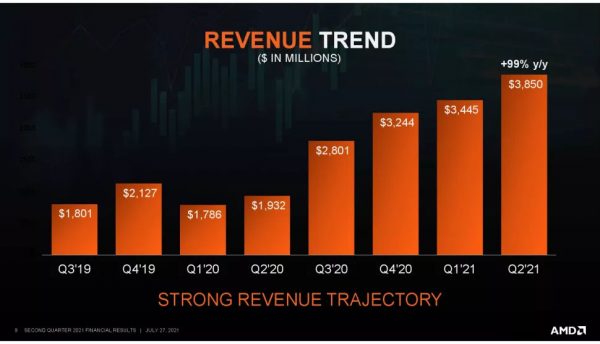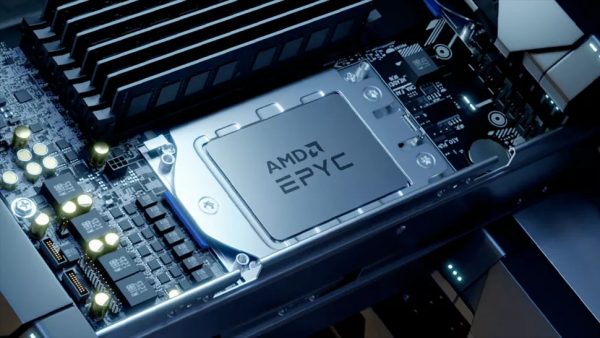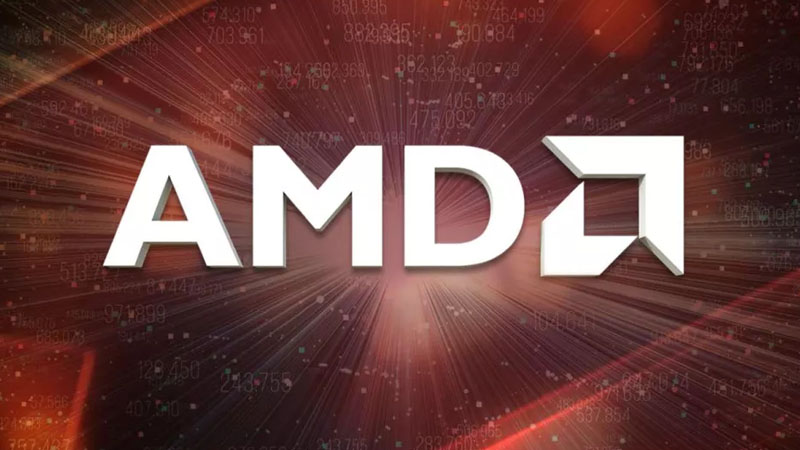In recent years, AMD’s revenue has grown steadily. In 2020, the company reached a record figure of $ 9,763 billion dollars, and for this year, there is talk of a growth of 60%, reaching $ 15.5 billion. It seems like a difficult goal to achieve in the midst of a chip supply crisis. However, AMD is confident that it will achieve its goals for this and the next few years thanks to improved supply, increasing demand for HPC-grade hardware and servers, and a focus on premium models.
Devinder Kumar, AMD CFO, said at the 2021 Deutsche Bank Technology Conference:
We believe that we can sustain this revenue growth, both on the demand side of our consumers as well as the supply line of our foundry partners, substrate suppliers and ATPM (assembly, testing, marking and packaging), there is significant room for that we grow until 2022 and 2023

So far this year, AMD’s sales have been very strong. The company earned $ 7.295 billion in the first two quarters of the year and is on track to meet the goal of increasing its revenue by 60% each year.
To achieve this financial goal, AMD had to prioritize making products that it had committed to supplying, as well as high-margin models, which meant giving up unit ownership. In fact, AMD gained unit share and revenue from mobile client PCs and servers, even though its share of desktop units fell in the second quarter of 2021 (despite having some of the best CPUs). Meanwhile, the company’s share of the discrete desktop and laptop GPU market fell to a multi-year low in the second quarter of 2021.
Regarding this, Kumar added:
Our top priority is that if we are committed to our customers, we want to make sure that we can supply the parts to the customers. The second thing we look at from a general demand versus supply point of view,… data centers are a high priority. Then the PC business, particularly with the high-end of the stock. We want to ensure that we can maintain and increase business growth in that area.
When it comes to data centers and servers, AMD is particularly competitive with its 2nd and 3rd generation EPYC processors codenamed Rome and Milan featuring up to 64 cores, something that Intel cannot offer. Up to this point, AMD EPYC CPUs have had success with OEMs supplying businesses. But as cloud data center operators are increasing the use of EPYC chips, the company has to meet additional demand for its server processors.

In addition, these EPYC processors are designed to cover another important market: Supercomputers. AMD has won and completed several supercomputer contracts with EPYC processors, however its primary design for Oak Ridge Leadership Computing Facility’s Frontier 1.5 ExaFLOPS supercomputer, as well as Lawrence Livermore National Laboratory’s El Capitan 2+ ExaFLOPS supercomputer, has yet to have been delivered.
Both Frontier and EL Capitan use AMD EPYC processors in conjunction with Instinct compute GPUs based on the HPC-specific CDNA architecture. Frontier by itself will mean AMD, HPE and others about $ 600 million.
GPUs for gamers, not miners
Recent demand for discrete GPUs for desktops and laptops has grown significantly but AMD was unable to really capitalize on this in terms of unit shipments. The company could take advantage of demand and raise its prices, especially on high-end models. But Steam hardware surveys show 11 times more gamers are using Nvidia’s 3000 series over AMD’s RX 6000 series. There are those who accuse AMD of selling its Radeon GPUs to large mining farms instead of selling them to retailers.
AMD’s CFO denied these allegations, saying the miners’ demand was negligible. He also noted that while the company does not prioritize its GPU customers, Radeon GPUs were for gamers, not miners.
Many years ago, AMD couldn’t afford major investments in its graphics business and prioritized its CPU businessas it had a clear roadmap with visible returns. This is why Nvidia can outsell AMD today significantly. What would be interesting to know is whether AMD is investing enough in its GPU business now and if this will be enough to capture a sizeable market share from Nvidia for several years to come.
Finally, AMD remains optimistic about its future in the medium term, as demand for its products is growing in all market segments. For the first time in its history, AMD has very competitive processors for virtually all major applications. This, combined with the generally high demand for computers, makes it difficult for the company to meet 100% of the demand it faces.
Will AMD be able to achieve 60% of the annual growth it seeks?
Source: Tomshardware.















